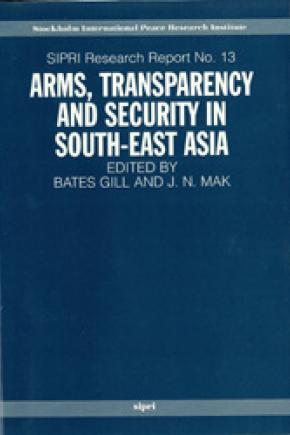The dynamism of South-East Asia in terms of multilateral diplomacy, economic growth, social change and military modernization both promises the possibilities of stable prosperity and threatens the outbreak of troubling tensions. The issues of arms, transparency and security in South-East Asia are intricately interwoven with the larger dynamics of change in the region. These issues will affect the outcomes, peaceful or otherwise, of the region's complex interactions. In recent years a nascent effort has emerged among official and unofficial observers to consider whether and how openness and transparency in arms and defence-related matters might serve as a confidence-building and security-enhancing measure in South-East Asia and in the Asia-Pacific region more broadly. Little in the way of concrete suggestions has emerged at either the official or the unofficial level in South-East Asia.
In seeking to fill these gaps in the understanding of South-East Asian security, this book addresses three fundamental questions:
- What conceptual frameworks give shape to efforts to develop transparency measures on arms and defence-related matters in South-East Asia?
- What current strategic and political conditions and policies in South-East Asia either support or undermine movement towards transparency in South-East Asia?
- What initial pragmatic and security-enhancing steps might be taken towards developing greater transparency in South-East Asia?
Basic principles and definitions
Three core principles infuse the contributions to this volume. First and most important is the belief that properly developed transparency measures can make an effective and sustained contribution to improving security among neighbours in the international community and in South-East Asia in particular. This principle rests on the understandings that such a process can in itself serve as a confidence-building measure (CBM) and that such openness will help to clarify intentions, dispel suspicions and open new avenues for cooperation, laying the groundwork for trust and improved relations.
Early on in the development of the United Nations Register of Conventional Arms (UNROCA), the world's foremost arms trade transparency mechanism, transparency was promoted 'so as to encourage prudent restraint by States in their arms exports and to reduce the risks of misunderstandings, suspicion or tension resulting from lack of information concerning arms transfers'.
Considerably more theoretical and empirical work needs to be done to further delineate and explain the linkage between transparency and security, or between arms build-ups and the outbreak of instability. The work in this volume represents a step in this process, particularly as these efforts apply to South-East Asia.
A second important principle is that transparency must be understood in an inclusive sense, to incorporate arms-related transparency mechanisms such as arms registers as well as consultative bodies to address arms build-ups, the sharing of defence-related information through such means as White Papers and other exchanges of militarily relevant information and data. This approach differs in many ways from others which place a too narrow emphasis on a United Nations-style arms trade register—an approach which is flawed in at least three important respects.
First, the UNROCA, in spite of its many successes, has a number of shortcomings as an arms-related transparency mechanism. While it provides useful information, it does not provide for a consultative mechanism or forum in which the countries concerned can discuss and address the information available in the UNROCA. Second, the reporting categories of the UNROCA may not be well suited to the concerns of South-East Asia and it does not require reporting on current weapon holdings and domestic production. Third, submissions are entirely voluntary and unenforceable, which means that states may freely choose not to participate.
Thus, wholesale adoption of the UNROCA or a similar arms trade register system would not meet region-specific arms trade concerns, nor would it adequately address concerns through the all-important vehicle of a consultative mechanism. The discussion in this volume recognizes these potential drawbacks and offers a more inclusive and flexible approach to what is meant by transparency in arms- and defence-related matters.
A third principle is shared by the contributors: that South-East Asia is particularly well suited as a region to achieve considerable progress in debates on openness and information sharing concerning arms and defence matters. First, in December 1994, following the 1994 review of the UNROCA, the UN General Assembly voted to wait until 1997 before reviewing it again, even though the 1994 review had failed to reach consensus on ways to promote its further development. In the interim and beyond the 1997 review, efforts to refine the UNROCA must turn elsewhere, with the potential for regional developments holding the most promise—as in South-East Asia.
Second, South-East Asia is a relatively small region, which makes it easier to develop multilateral approaches to arms trade and defence-related transparency mechanisms. The size and scale of the group also mean that arms acquisitions, holdings and domestic production are relatively small, which will make information-sharing and -monitoring efforts relatively easier.
Third, throughout the nearly 30-year history of the Association of South-East Asian Nations (ASEAN) most countries of South-East Asia have developed substantial experience in multilateral approaches to diplomatic problem-solving. To put it another way, an official culture of cooperation and openness at the regional level already exists, often known as the 'ASEAN process' or 'ASEAN way', a form of cooperative multilateralism that is noticeably absent elsewhere in the Asia-Pacific region and throughout most of the world. The ASEAN way will present a number of obstacles to developing arms- and defence-related transparency mechanisms in South-East Asia. At the same time, however, its flexibility, informality and consensus-building aspects have proved amenable in the past to concepts of comprehensive security and CBMs.
Fourth, the region is currently embarked on a substantial arms modernization drive which is unfolding amid continuing unresolved differences and security problems and against a background of the development of more externally oriented and contingency-driven security and arms acquisition policies. Under these conditions arms build-ups, unless properly handled, could result in unnecessary tensions, suspicions and instabilities. Exploration and possible implementation of arms-related transparency approaches seem to be warranted as a means to ease the uncertainties presented by the current arms modernization process in South-East Asia.


